There are so many different types of cheese (~500 different varieties recognized by the International Dairy Federation), what are the differences between them? How to tell whether I'll like them?
Fret not, while no single method is used universally, we attempt to classify some of the more commonly found cheese in Singapore as well as you might have tried overseas based on their texture. Hopefully this will help you enjoy cheese better :)
Ready to eat within a few days, or even hours, of being made, fresh cheeses are so young that they barely have time to develop any more than a whisper of the milk's potential flavor, so the taste is typically described as lactic or milky, sweet, lemony, refreshing, citrusy or acidic. This does not mean they are bland.
On the contrary, the skill of the true craftsman can coax the subtle flavors from the milk; the sweet, grassy notes of cow's milk; the aromatic, herbaceous character of goat's milk, with its hints of white wine and crushed almonds; the richness of sheep's milk that suggests Brazil nuts, caramelized onions, and roast lamb; the leathery, earthy undertones of buffalo's milk.
| Uncooked | The microscopic fat globules trapped in fresh cheeses absorb and concentrate the flavors of the other ingredients, transforming the simplest dishes into classics like Feta in a Greek salad, Cream cheese with smoked salmon, or Mascarpone in tiramisu. Consequently, fresh cheese is used to add texture to a recipe rather than to give it additional flavor. Fresh cheeses destined for the cheese platter are often decorated, rolled or dusted in ash, herbs or spices to enhance their appearance and flavor. |
| Cooked | Fresh cheeses are at their best when melted or baked in classic dishes, such as Feta in Spanakopita, Ricotta in Ravioli, or Mozzarella on Pizza. However, their high moisture content and loose texture means they fall apart in sauces and become tough when broiled too long. |
| With Drinks | With their high acidity, fresh cheeses are best with crisp white wines or cider. For a nonalcoholic alternative, try apple juice or elderflower cordial. However, when fresh cheeses are combined with other ingredients, choose a wine that complements the more dominant flavors. |
|
Halloumi |
A harder, denser texture than other fresh cheeses because the curd has been "kneaded". The brine it is preserved in gives it a salty tang. |
|
Feta |
Dense, creamy and crumbly in texture, it is preserved in brine, giving it a salty taste and texture. |
|
Ricotta |
A soft, moist, fragile whey cheese. |
|
Mozzarella |
Because the fresh curd is placed in hot water, this cheese is very elastic and can be stretched and formed into different shapes. |
|
Mascarpone |
Sweet in flavor, it is made by heating cream rather than milk. |
Camembert de Normandie and Brie de Meaux are the best-known examples and the inspiration behind the variations produced around the world. Soft white cheeses typically have a white crust, a slightly grainy to almost runny texture, and a wonderful aroma of mushrooms. The coat protects the cheese from drying out and speeds up the ripening process; hence, they are sometimes called mold-ripened cheeses.
The mildest cheeses hint of sweet hay and button mushrooms; the strongest taste like creamy wild mushroom soup and finish with the peppery bite of dandelions and have an earthy aroma reminiscent of cool cellars and mushrooms warmed in butter. Those made with sheep's milk have a subtle sweetness with just a hint of roast lamb, while those made with goat's milk taste of almonds or even marzipan.
| Uncooked | These wonderful cheeses are at their very best when served at room temperature with crusty bread and a glass of wine. |
| Cooked | A popular recipe involves baking a small soft white cheese for about 15 minutes and scooping out the molten interior with chunks of bread or raw vegetables. These cheeses also broil well; try them on a croissant layered with roasted peppers or sweet chutney, but cut off the rind around the sides, because it will become dry and a little bitter. |
| With Drinks | The French serve cider or calvados with Camembert, Chardonnay with Brie de Meaux and Champagne with Chaource. As a general rule, goat's or sheep's milk variations work very well with similar wines. Alternatively, try a tawny port with a strong soft white. A hoppy pale ale (rather than a bitter beer) works with the milder, sweeter cheeses. |
Brie de Meaux
|
Probably the strongest of all the soft white cheeses, with an intense mushroom aroma. |
Camambert de Normandie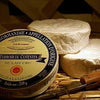
|
France's other famous soft white comes packed in wooden boxes. Ripe examples have pink or brown-tinged rinds. |
Brillat-Savarin
|
Extra cream added to the milk triples its fat content to 75% and gives this cheese a wickedly rich feel. |
Capricorn Goat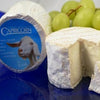
|
One of England's first soft white goat cheeses, it has a stark white interior typical of goat's milk cheeses. |
All semi-soft cheeses are washed in brine to discourage unwanted molds. Semi-soft cheeses vary in appearance and texture more than any other cheese type, but can be divided into 2 styles.
Dry rind cheeses ripen slowly and range from springy, mild, sweet and nutty with barely formed rinds, to rubbery, floral and pungent with thick leathery rinds. When made with goat's milk, they are mild and nutty, with a hint of marzipan.
Those with a sticky orange rind are called washed-rind cheeses and are softer and have a pungent, savory, barnyardy, smoky and even meaty taste and aroma. They tend to be grainy, with a softening just under the rind when young, and become soft and supple with age. The more they are washed, the softer, stickier and smellier the rind. The washed-rind type includes those known as Trappist or monastery-style.
| Uncooked | Mild semi-soft cheeses such as Edam or Havarti are classic breakfast cheeses, while the stronger varieties are essential on any cheese platter. |
| Cooked | The dry-rind cheeses are superb when broiled, since their rubbery texture stretches but holds its shape - but for the same reason they do not work well in sauces. Washed-rind cheeses, however, melt superbly in sauces, although a little goes a long way. When they are baked whole, they become sweeter and more savory, which makes them an amazing appetizer. |
| With Drinks | The milder cheeses need a Chardonnay, a light red like Merlot or beer, but more acidic wines will make the cheese taste sour. The pungent washed-rind cheeses are superb with beers, ciders and sweeter grape varieties such as Riesling or Gewurztraminer. These wines highlight the fruity, sweet meadow-flower character that is usually hidden beneath their barnyardy aroma and taste. |
Edam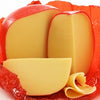
|
A washed-curd cheese and has a sweet flavor, a rubbery texture, and a very thin, barely formed rind dipped in a protective coat of red wax. |
Taleggio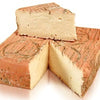
|
The fine, dry rind feels gritty and has patches of grey and white molds. A stamp of quality and authenticity marks its rind. |
Vacherin Mont d'Or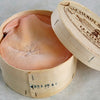
|
The thick rind of this cheese protects the moisture inside, and as a result, the interior is a runny liquid. |
Stinking Bishop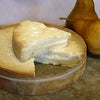
|
This washed-rind cheese is splashed or rubbed in brine mixed with perry (or fermented pear juice). It is named after the pear variety used to make the perry. |
The large wheels, cylinders and drums of hard cheese found in all traditional cheesemaking countries are typically made with cow's, goat's or sheep's milk. Their rinds range across the spectrum from smooth with polished rinds to rough and pockmarked like the Moon's surface.
Flavors grow complex as they mature; very old hard cheeses such as Parmigiano-Reggiano and Dry Jack become granular, giving the cheese a crunchy feel in the mouth. Classic sheep's milk hard cheeses, such as Manchego and Pecorino, have a dense, slightly grainy texture with an oily-yet-dry feel in the mouth, a characteristic sweet caramelized onion flavor and an aroma reminiscent of roast lamb or wet wool. Hard goat's milk cheeses have a subtle almond taste.
Hard cheeses can vary greatly in appearance. Traditional hard British cheeses are cloth-bound drums or tall cylinders. The Dutch and Swiss tend to make large boulders or wheels with polished or waxed rinds. Spanish cheeses usually bear the imprint of braided reeds or the wooden molds in which they were drained. Producers in France and Italy make hundreds of different hard cheeses, from smooth, barrel-shaped Pecorino to enormous wheels of Beaufort with its thin, tough rind.
| Uncooked | The most versatile of any cheese type, hard cheeses are ideal for cheese platters. The can also be shaved or grated into salads, dips and dressings - for instance, Parmigiano-Reggiano in pesto. |
| Cooked | Hard cheeses play an integral role in the culinary history of the country where they are made. Thermized cheeses such as Gruyere and Beaufort become stretchy when heated, making them perfect for broiling or fondues rather than in sauces. Others melt completely, while very hard cheeses such as Parmigiano-Reggiano simply dissolve, adding flavor but not texture; both these styles are excellent when added to sauces, pasta and soups. |
| With Drinks | Their high fat content and stronger, more intense taste marries best with red wines. They absorb the rough edges of young wines or soften the tannin in wines such as Cabernet Sauvignon or Barolo. White wines bring out the fruitier nature of the cheese, while beer and cider, with their natural acidity, make equally good companions. |
Cheddar
|
Cheddar curds are cooked at 40oC, then milled before being pressed to create a smooth, very creamy texture and a savory, raw-onion tang. |
Pecorino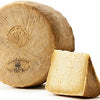
|
A popular sheep's milk cheese (pecora = sheep in Italian), it is firm with a pungent, salty, full and long-lasting flavor. |
Grana Padano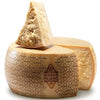
|
Curds cut into rice-sized pieces give this cheese a brittle texture. It has a thick, hard rind from soaking in brine for 21 days and tastes sweet, like ripe pineapple. |
Emmentaler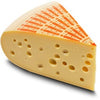
|
The milk is heated to 54oC, a process known as thermizing, resulting in sweet, fruity flavors and an elastic texture. |
Mimolette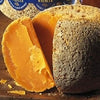
|
This cheese has a dry crust that is often attacked by harmless cheese mites, creating a rind like a rusty cannonball. |
There is extraordinary variety in taste and texture, but blues all have a spicy, slightly metallic tang, often taste saltier than other cheeses, and attract a rainbow of colorful molds that exude a powerful aroma. Blue molds are members of the penicillin family but, unlike white molds, they prefer to grow inside a cheese.
They create a seemingly endless array of wonderful cheeses, from dense, buttery Stilton to sweet Gorgonzola with its luscious, gooey texture and spicy tang. Sheep's milk blue cheeses such as Roquefort retain the sweet, burnt-caramel taste of the milk that offsets the sharp, salty, steely blue finish.
Most European blue cheeses are wrapped in tin foil, ensuring that their rinds remain damp and sticky and develop a multitude of molds layered on them, while traditional British blues have rough, dry, crusty, orange-brown rinds, often splashed with blue and grey molds.
The moist interiors of wet-rind blues develop wide, uneven streaks and pockets of blue, whereas dry-rind blues have a dense, compact texture that develops thinner, longer streaks and looks like shattered porcelain when cut. There are also soft white blues, which have white rinds and patches of blue.
| Uncooked | Blue cheeses are essential on any cheese platter and, with the exception of the Brie-style blues, also add another dimension to salads, especially when crumbled over cannelloni beans, walnuts, and peppery arugula dressed with honey vinaigrette. Walnut bread is especially good with blue cheeses, and a drizzle of honey brings out the subtlety of the cheese. |
| Cooked | Stir small amounts into pasta, soups and sauces to elevate dishes into classics like celery and Stilton soup; pasta with pine nuts and Gorgonzola; or grilled steak with blue cheese sauce. |
| With Drinks | Try a tawny or late-bottled-vintage (LBV) port rather than the richer vintage or less complex ruby ports, as they tend to overpower the majority of blue cheeses. If port is not to your taste, a sweet or dry Riesling can make a perfect partner. Match the dessert wine Sauternes only with the very sharp, salty, steely blues, such as Roquefort, with its sweet undertones. |
Stilton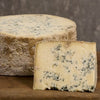
|
This cheese has the dry rind typical of many British blue cheeses. The dense, buttery interior forces the blue mold to develop as thin broken streaks. |
Roquefort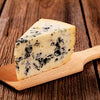
|
The famous sheep's milk blue has a loose, moist interior, allowing Penicillium Roqueforti to grow en masse as thin streaks and large scattered pockets. |
Gorgonzola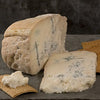
|
Thick, blue-green streaks and scattered patches fill the interior. Its thin wet, sticky rind, finely dusted with mold, typifies traditional European blues. |
Bavaria Blu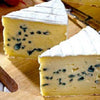
|
This is a soft white-style blue. Pockets (rather than streaks) of blue result from injecting blue mold directly into this creamy, dense cheese. |
With their bright colors, the vast array of flavor-added cheeses stands out on deli counters across the world. Smoked cheeses have existed since humans learned to make hard cheeses and stored them near their wood fires. In the 16th century, Dutch cheesemakers incorporated the exotic spices brought back from the East Indies into Edam and Gouda, producing a tantalizing melange of flavors. Today, most flavor-added cheeses are well-known hard cheeses blended with fruit, spices or herbs, and shaped into a round.
Flavor-added cheeses can be divided into 4 distinct types.
| Uncooked | The choice of flavors to add to cheese is limited only by the imagination of the cheesemaker. Flavor-added cheeses with dried fruit are typical served in place of dessert, while only those with garlic, herbs, chives or that are smoked work in salads. |
| Cooked | Traditionally made semi-soft or hard flavored cheeses behave like their unflavored counterparts when cooked and can add character to basics like baked potatoes or pasta - smoked cheeses work especially well for this. |
| With Drinks | Beers nicely complement savory-flavored cheeses with onion, chives, garlic, oak smoke and chili peppers, while the sweet dessert cheeses are better with cider or Chardonnay. The tannin and red berry flavor of red wines tends to clash with all but the hard cheeses like cheddar with garlic or Gouda with peppercorns or Pecorino with Saffron. |
Piacentinu Enna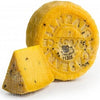
|
First recorded in the days of the Roman Empire, this cheese is flavored with saffron and black pepper and is shaped in traditional reed baskets. The outside and inside are yellow-orange from the addition of saffron, and fantastic for melting. |
Yarg Cornish Cheese
|
Probably the best-known British example of a rind-flavored cheese, its elegant rind of interwoven forest-green nettles imparts a subtle flavor. |
Nagelkaas
|
This traditional-style flavor-added cheese from the Netherlands is based on a Gouda recipe and uses cloves. The orange color comes from adding annatto (a natural dye derived from the seeds of Bixa orellana) and provides an attractive contrast to the dark cloves. Nagelkaas means 'nail cheese'. This refers to the shape of the cloves studded in its interior. |
Taramundi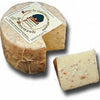
|
This traditional-style Spanish cheese has a semi-soft texture and is made by adding local crushed walnuts and hazelnuts. One of only few cheeses with nuts added. |
Cheese tastings: 6 to 8 cheeses are about all one palate can manage. Count on about 15g each cheese per person.
Cheese as an appetizer with other snacks: 3 cheeses, 30 to 45g each per person.
Cheese as the only appetizer: 3 to 4 cheeses, 30 to 60g each per person.
Cheese plates to begin or end a meal: 3 to 4 cheeses, 25 to 30g each per person.
Cheese preceding dessert: 3 cheeses, 25g each per person.